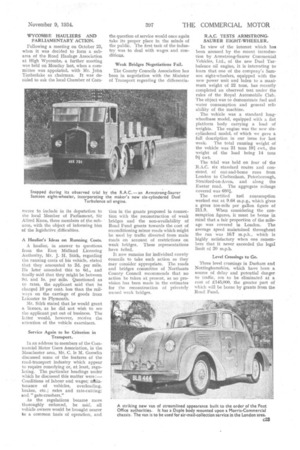Following a meeting on October 25, when it was decided
Page 53

If you've noticed an error in this article please click here to report it so we can fix it.
to form a subarea of the Road Haulage Association at High Wycombe, a further meeting was held on Monday last, when a committee was appointed, with Mr. John Timberlake as chairman. It was decided to ask the local Chamber of Corn merce to include in its deputation to the local Member of Parliament, Sir Alfred Knox, three members of the subarea, with the object of informing him of the legislative difficulties.
A Haulier's Ideas on Running Costs,
A haulier, in answer to questions from the East Midland Licensing Authority, Mr. J. H. Stirk, regarding the running costs of his vehicle, stated that they amounted to 2d. per mile. He later amended this to 6d., and finally said that they might be between 9d. and is, per mile. Questioned as to rates, the applicant said that he charged 10 per cent less than the railways on the carriage of goods from Leicester to Plymouth.
Mr. Sdrk stated that he would grant a licence, as he did not wish to see the applicant put out of business. The latter would, however, receive the attention of the vehicle examiners.
Service Again to be Criterion in Transport.
In an address to members of the Commercial Motor Users Association, in the Manchester area, Mr. C. le M. Gosselin discussed some of the features of the road-transport industry which appear to require remedying or, at least, regulating. The particular headings under which he discussed this matter were:— Conditions of labour and wages; Olintenance of vehicles, overloading, brakes, etc.; rates and rate-cutting; and " gate-crashers."
As the regulations became more thoroughly enforced, he said, all vehicle owners would be brought nearer to a common basis of operation, and the question of service would once again take its proper place in the minds of the public. The first task of the industry was to deal with wages and conditions.
Weak Bridges Negotiations Fail.
The County Councils Association has been in negotiation with the Minister of Transport regarding the differentia tion in the grants proposed in connection with the reconstruction of weak bridges and the non-availability of Road Fund grants towards the cost of reconditioning minor roads which might be used by traffic diverted from main roads on account of restrictions on weak bridges. These representations have failed.
It now remains for individual county councils to take such action as they may consider appropriate. The roads and bridges committee of Northants County Council recommends that no action bc taken at present, as no provision has been made in the estimates for the reconstruction of privately owned weak bridges.
R.A.C. TESTS ARMSTRONGSAURER EIGHT•WHEELER.
In view of the interest which has been aroused by the recent introduction by Armstrong-Saurer Commercial Vehicles, Ltd., of the new Dual Turbulence oil engine, it is interesting to learn that one of the company's Samson eight-wheelers, equipped with the new power unit and laden to a maximum weight of 22 tons, has recently completed an observed test under the rules of the Royal Automobile Club. The object was to demonstrate fuel and water consumption and general reliability of the machine.
The vehicle was a standard longwheelbase model, equipped with a flat platform body carrying a load of weights. The engine was the new sixcylinderecl model, of which we gave a full description in our issue for last week. The total running weight of the vehicle was 21 tons 191 cwt., the weight of the load being 14 tons 91 cwt.
The trial was held on four of the R.A.C. six standard routes and consisted. of out-and-home runs from London to Cheltenham, Peterborough, Stratford-on-Avon, and along the Exeter road. The aggregate mileage covered was 6801.
The certified fuel consumption worked out at 9.64 m.p.g., which gives a gross ton-mile per gallon figure of 211.9. When considering the consumption figures, it must be borne in mind that a fair proportion of the mileage was covered in London. The average speed maintained throughout the run was 16.7 m.p.h., which is highly satisfactory when one remembers that it never exceeded the legal limit of 20 mph.
Level Crossings to Go.
Three level crossings in Durham and Nottinghamshire, which have been a source of delay and potential danger to traffic, are to be eliminated at a cost of :C145,000, the greater part of which will be borne by grants from the Road Fund.
























































































































